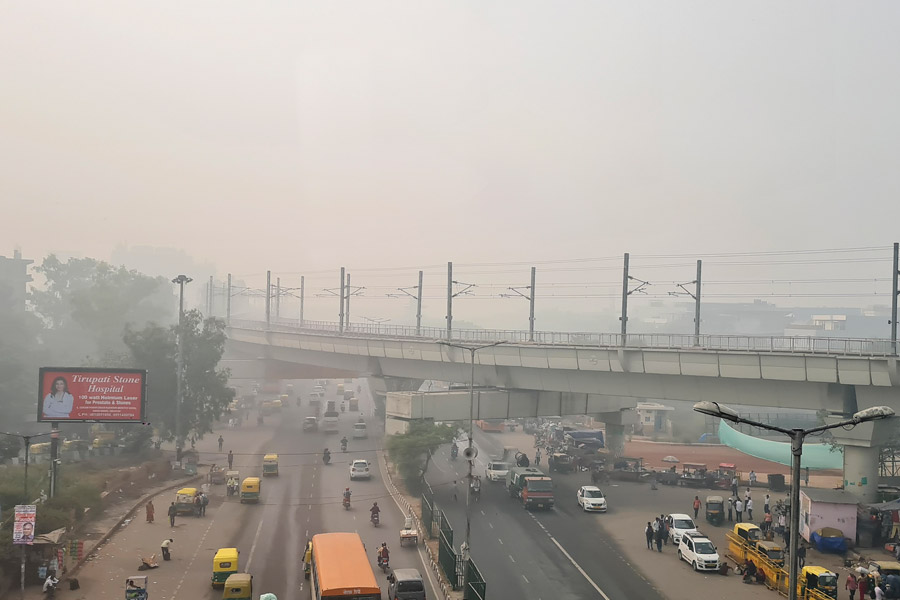Toxic fog persists over Delhi-NCR, pollution levels seven to eight times higher than safe limit
Stage IV of GRAP implemented in Delhi, construction work banned, schools closed

As a poisonous cloud continued to linger over the area for the seventh day in a row, pollution levels in Delhi-NCR on Monday morning were estimated to be seven to eight times higher than the government-mandated safe limit.
Tight restrictions, which included a ban on the entrance of vehicles that emit pollutants, were implemented in Delhi on Sunday after the city's air quality fell into the "severe plus" category for the second time in three days as a result of unfavorable wind patterns and a major increase in field fires around northern India.
Stage IV of the Center's air pollution management strategy, known as the Graded Response Action strategy (GRAP), required the Center to take all necessary emergency actions when the 24-hour average Air Quality Index (AQI), which is measured at 4 pm every day, deteriorated from 415 on Saturday to 454 on Sunday.
GRAP classifies acts into four categories: 'Very Poor' (AQI 301-400) for Stage II, 'Poor' (AQI 201-300) for Stage III, 'Severe' (AQI 401-450), and 'Severe Plus' (AQI 450) for Stage IV. The city's AQI was 440 on Monday at seven in the morning.
A number of cities in the nearby states of Uttar Pradesh, Rajasthan, and Haryana have also reported dangerously low air quality.
Hazardous air quality was also observed around 7 am in the nearby cities of Ghaziabad (413), Gurugram (369), Noida (403), Greater Noida (396), and Faridabad (426).
According to the India Meteorological Department (IMD), an impending western disturbance—weather systems that originate in the Mediterranean region and bring unseasonal rainfall to northwest India—is expected to have an impact on the development of favorable conditions for the dispersion of pollutants starting Tuesday night.
At some areas throughout Delhi-NCR, the quantity of PM2.5, a small particulate matter that may enter the respiratory system deeply and cause health issues, was seven to eight times higher than the government-mandated safe limit of 60 micrograms per cubic meter. The WHO's recommended safe threshold of 15 micrograms per cubic meter was 30 to 40 times higher.
Doctors have reported that individuals with pre-existing respiratory conditions have been experiencing severe complications as a result of the toxic fog.
Unfavorable weather patterns, car emissions, burning paddy straw, firecrackers, and other regional sources of pollution all play a part in the dangerously high levels of air pollution that Delhi-NCR experiences every winter.
The Delhi Pollution Control Committee (DPCC) reports that as the number of stubble burning occurrences in Punjab and Haryana rises, the city faces peak pollution from November 1 to November 15.
The Indian Agricultural Research Institute (IARI), located in New Delhi, reports that 4,160 agricultural fires were recorded from north India on Sunday, making it the most so far this season.
Based on statistics from the Punjab Remote Sensing Centre, Punjab alone recorded 3,230 stubble burning occurrences, the greatest number of incidents in a single day this season in the state.
In order to combat pollution in the region, the Commission for Air Quality Management (CAQM), a statutory body, has asked the states of Delhi and the National Capital Region (NCR) to prohibit construction work related to linear public projects and permit fifty percent of employees in government and private offices to work from home.
Only electric, CNG, and BS VI compliant cars from other states are permitted entry into Delhi under Stage IV of the GRAP. Individuals engaged in critical services are the only ones eligible for exemptions. As per the most recent CAQM directive, medium and heavy freight trucks that are not involved in providing critical services are prohibited from operating in the capital.
On November 2, the CAQM issued an order prohibiting certain types of polluting cars and non-essential building activities.
Additionally, the Delhi government has declared that all elementary schools would be closed for two days in an attempt to protect young children from dangerous pollution.
The previous week has seen a fall in Delhi-NCR's air quality because to a steady drop in temperature, calm breezes that don't help to spread pollutants, and an increase in the burning of post-harvest paddy straw across Punjab and Haryana.
Delhi’s air quality index jumped by more than 200 points between October 27 and November 3, placing it in the'severe plus' category on Friday, according to data from the Central Pollution Control Board (CPCB).
The 24-hour average AQI on Friday, 468, was the lowest since November 12, 2021, when it reached its previous level of 471.
A groundbreaking research that the Delhi government had initiated to assist identify various causes of pollution in the city and then take mitigation measures was recently discontinued on the instructions of DPCC Chairman Ashwani Kumar, despite the fact that the capital is now experiencing an air crisis.
Gopal Rai, the environment minister for Delhi, claims that Kumar also "unilaterally" ordered the shutdown of a sizable smog tower that was put in place at Connaught Place two years ago in an effort to reduce local air pollution.
Of all the capital cities in the world, Delhi has some of the worst air quality.
According to a research released in August by the Energy Policy Institute at the University of Chicago (EPIC), air pollution in Delhi is causing people to live shorter lives by almost 12 years.
Except for the headline, this story has not been edited by Press Time staff and has been published from a syndicated feed.



























































